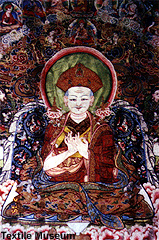|
Bhutan
- The Land of Weaving and Textiles
|
 |
Bhutan's
Economy Textile Industry |
|
 |
Bhutan Information |
|
|
 |
|
Textile
Museum in Thimphu - Preserving and promoting a national heritage
|
 |
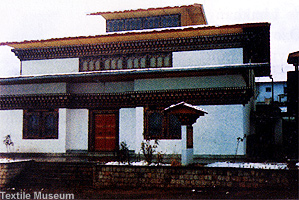 |
| Textile Museum in Thimphu |
Not
long after the opening of the National Textile Museum on June
12, 2001 Bhutanese textiles have reached
new heights as one of the most visible traditional crafts and as a distinctly
Bhutanese art form.
The
textile museum has opened its exhibition on six major themes - warp
pattern weaves, weft pattern weaves, role of textiles in religion, achievements
in textile arts, textiles from indigenous fibres and the royal collection. |
|
Conceived
and patronized by Her Majesty the Queen Ashi Sangay Choden Wangchuck,
the basic infrastructure of the museum was constructed at a cost of US$
165,000 with Danish assistance. Private donors and the government
also contributed. The Peabody Essex museum in the United States provided technical support to set up the museum. It is managed by the national
commission for cultural affairs.
It
charges a visiting fee of Nu. 10 per person for local people, Nu. 25 for
those from the SAARC region and Nu. 150 for westerners. The museum
earns an average of Nu. 7-8000 in a month from visiting fees. Throughout
this week the museum received a steady flow of visitors most of whom were
interested in the royal collection.
top
| Highlight
of the exhibition is the royal collection |
 |
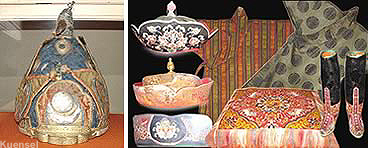 |
| Rare
items on display:
The
crowns of Bhutan's Kings, namzas and other accessories used by members
of the royal family.
The
first version of the Raven crown. |
|
The
the royal collection includes the first version of the raven crown, a brocade
uzham (crown) worn by the first king, another uzham worn by
the second king, and a princess crown worn by the sister of the first king, Ashi
Wangmo. Namzas (dresses) and other accessories worn by the kings
of the Wangchuck dynasty and other members of the royal family are
also on display. The royal collection was lent to the museum by Her
Majesty the Queen Mother, Ashi Kezang Choden Wangchuck, and some private
individuals.
| The
exhibition and its display setting was conceived entirely by the museum
staff none of whom have undergone any formal training.The museum through
the exhibition hoped to generate interest among the weaving community to
reintroduce traditional patterns and help foster understanding of Bhutan's
unique achievements in the textile arts. |
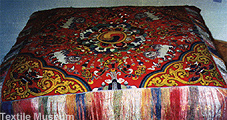 |
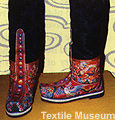 |
| The
goal of the museum is to slowly become a center for textile studies that will carry out Document, research and studies on textiles. |
|
|
|
It has
already started doing this on a small scale.
The
museum is planning numerous activities to kindle public interest and generate
revenue for itself.
top
| The
national design competition |
 |
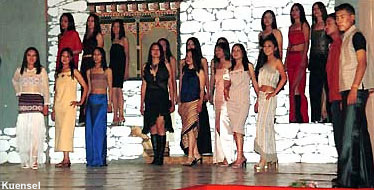 |
| The national
design competition will
have a new feature - the best textiles during the competition will be selected
through public polling and not by a panel of judges. All textiles will
be assigned numbers and visitors will cast their votes "for the best piece"
on the numbers and not on the creators. A new category in the competition
this year, besides the pesar, traditional and innovative designs, will
be appliqué and embroidery. |
|
The
museum is also planning to hold a textile festival during the design competition.
top
| Auction
of modern contemporary |
 |
An auction
of modern contemporary textiles is "under consideration". The museum
will buy the best pieces of textiles from all interested weavers and sellers
around the country. The "base price" for all pieces during the auction
will be the original price quoted by the weavers. The bid amount exceeding
the base price will go to the textile museum. This is essentially to encourage
weavers to come up with better quality textiles having more intricate and
appealing designs. The museum will soon employ two permanent weavers -
one for pangtha and another for thuetha - so that visitors can see how
the textiles are actually woven.
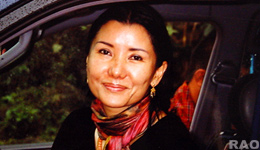 |
| Her
Majesty the Queen Ashi Sangay Choden Wangchuck
Her
Majesty is also patron to the National Textile Museum inaugurated in 2001.
Her personal interest in national textiles has been instrumental in boosting
Bhutan's textile art spurring both national and international interests.
This has not only provided due recognition to the nations textiles but
has also created a platform for weavers of the kingdom. The Museum is now
in possession of an invaluable collection of antique textile artefacts
through friends and well wishers. Conservation and Protection of national
treasure textile artefacts, such as the pearl robe from Tsamdrak goenpa,
personal bedding of His Holiness Zhabdrung Jigme Dorji and the Raven crown
are some of the Museums remarkable feats. |
|
| This
article was contributed by KUENSEL, Bhutan's National Newspaper |
 |
| Information on Bhutan |
 |
|








